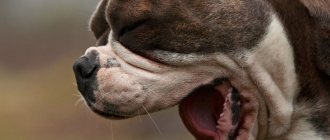Calm and even breathing of an animal is one of the markers of your pet’s health. Accordingly, if a dog suddenly begins to choke, this causes alarm to the owner. On the other hand, such physiological changes can be provoked by active jogging, prolonged exposure to heat or a stuffy room. Breathing problems may occur during sleep, before or during childbirth . In dogs of brachycephalic breeds, snoring during sleep is due to the specific structure of the nasopharynx and is not considered a deviation from the norm.
Why does a dog choke and grunt?
Most often, this is a non-threatening condition called “reverse sneezing.” It looks as if the dog is sucking in air through its nose with sharp sighs and as if it cannot exhale. She stands with her head bent, and it seems that the dog is suffocating.
There may even be a urge to vomit or even vomiting itself. The reasons for this condition are unknown to doctors. Such attacks begin suddenly and also pass, but they are not dangerous to the health of the animal. Another reason can be called dangerous - when a foreign object gets into the dog’s nasopharynx.
This attack is similar to a “reverse sneezing”, but it does not stop and threatens the dog with suffocation. A dog may also choke and grunt as a result of a heart attack. In this case, her tongue turns blue. Or fluid, air, or blood may accumulate in the animal's chest cavity.
Breathing may be difficult due to stress. For example, when a dog is afraid of fireworks or gunshots. Some breeds have such a nasopharynx structure that they often breathe very noisily, and also pant and grunt while jogging or playing.
There is also an unpleasant parasite that can cause this condition in a dog - heartworms. They are transmitted through the bites of blood-sucking insects, but it will not be possible to detect such a parasite on your own. It is necessary to immediately contact a veterinarian, otherwise the animal may die.
[custom_ads_shortcode1]
How to give a dog first aid
If you notice that your pet's condition is rapidly deteriorating (he has turned blue, is breathing heavily, and is sticking out his tongue), you need to help him. The first thing you should do is put the animal in a separate room, providing it with complete rest. The room should be cool, often ventilated, but without drafts.
However, if the dog does not want to lie down, then it is useless to insist, as is trying to force him to drink water - these actions can lead to the opposite result.
Call the veterinarian and describe your dog's condition in detail. Before the doctor arrives, you can give the dog crushed suprastin (for a weight of 5-8 kilograms - half a tablet), this will relieve swelling. Next you should massage the chest, back, abdomen and ears. If possible, you can inject the immunostimulant “Gamavit” into all four paws in equal doses.
If the clinical picture is severe, the doctor will have to saturate the animal’s body with oxygen using an oxygen mask. In some cases, artificial ventilation, closed lung massage, or surgery is required.
What to do if a dog is choking, how can you help?
- During an attack of “reverse sneezing,” you can gently stroke the animal’s throat.
- It is also helpful to pinch his nose to force the dog to open his mouth and take a deep breath. Then this “sneezing” will stop instantly.
- If the attack does not stop and there is a suspicion of a foreign object entering the nasopharynx or a heart attack, as well as respiratory diseases, the animal must be urgently taken to a veterinarian.
- However, if you see an object and you can pull it out yourself, it is better to act and try to carefully remove this object.
- If your dog is choking with fear in an anxious environment, you can simply give him a sedative prescribed by your veterinarian.
- If this condition recurs quite often, it is worth undergoing a course of special treatment.
Did you like it? Share with your friends!
Give it a like! Write comments!
Author: Alexey VelikovCopywriter. Writes articles on Internet resources about dogs. The owner of a Labrador named Woody.
Sometimes owners notice strange, spasmodic breathing, similar to suffocation. The pet takes sharp short breaths, strains its chest and front legs, and stretches its neck. At the same time, it makes grunting, guttural sounds, as if it is suffocating. There is profuse salivation. It’s interesting that this happens for no reason and unexpectedly, lasting from a few seconds to a couple of minutes. In everyday life, this is called “reverse sneezing”, since it really looks like sneezing inside yourself. All dog breeds are susceptible to this. Also known as “reversible cough” (from the Latin word “reversio” - return, return).
If you see this phenomenon for the first time, don’t panic! It looks dangerous, but in fact it is completely harmless. These spasms are caused by the structure of the nasopharynx of dogs, especially breeds with a short muzzle.
These are most often selective breeds. Unfortunately, thanks to the man, we got not only an interesting appearance, but also problems with the nasopharynx. The very physiology of the nostrils and palate has changed, causing breathing problems and even birth defects.
During stress, heat, or physical exertion, breathing quickens, the pet tries to take a deep breath, but the elongated soft palate prevents the movement of air: the expanding lungs put force on the trachea and larynx. This can worsen chronic diseases. Some owners witness attacks during overexcitement or after inhaling strong odors. But more often they occur for no apparent reason.
How to stop reversible cough in your four-legged friend?
You can help the sufferer: with one hand you need to close the nostrils - this will force him to breathe through his mouth, and with the other palm, stroke in the direction from the chin to the neck - this will reduce the tension and the spasm will stop. As a rule, immediately after the spasms stop, the dog feels well, and they are repeated infrequently.
Be sure to contact your veterinarian if: — attacks begin to occur more frequently;
- copious nasal discharge; - if your pet faints (this is very dangerous).
- The illness of a beloved dog is an unpleasant experience for both the pet and the owner. We understand the symptoms and causes of colds in dogs, and also provide a number of preventive measures that will help strengthen the immune system and reduce the risks of the disease. Read more These animals are the envy of many of us. After all, they are admired by millions of social media users. networks. Read more Ask friends and family for help? Or hire a professional dog sitter? Or maybe use the services of a special hotel for animals? We consider the pros and cons of all foster care options for your pets. More details
Quick, shallow breaths and a sticking out tongue are sure signs that your dog is having trouble breathing. This may be explained by the high temperature of the environment, or by the fact that a completely healthy animal is experiencing extreme thirst from the heat or from fatigue. Also, the dog suffocates in the presence of various diseases.
The pathological nature of difficulty breathing is indicated by such signs as noisy breathing (with “gurgling” and “grunting”), obsessive cough, cyanosis of the mucous membranes - cyanosis, which indicates an insufficient supply of oxygen to the body. A painful condition is indicated by general lethargy, rapid fatigue and weakness, refusal to eat, clouding of consciousness, intense thirst for no apparent reason, weight loss, diarrhea, nausea and vomiting - these can also be accompanied by difficulty breathing.
[custom_ads_shortcode2]
First aid for a dog with signs of suffocation: what can be done before the veterinarian arrives
The owner can provide first aid to a dog with signs of suffocation:
- The dog is immediately given complete rest; it must be isolated from loud noises, small children, etc.
- The air in the room where the sick animal is located should not be excessively dry or humid. We advise you to immediately ventilate and refresh the room.
- If there is a suspicion of asthma, or if your pet suffers from periodic attacks of suffocation of unknown etiology, it is advisable to carry out high-quality wet cleaning of the premises every day. But we do not recommend using chlorine or other “chemicals”, since chemicals can contribute to the development of new attacks.
- If the pet's condition gradually returns to normal, he can be given lukewarm, sweetened water. Just give the drink little by little: as soon as the dog choke, everything will start again. In addition, the animal can choke, choke and die.
Important! Under no circumstances should you hold or otherwise restrain an animal during an attack! If a dog develops severe enough hypoxia, it may well not recognize its owner, and therefore become dangerous.
Severe bites and other injuries in such situations are completely commonplace. To prevent troubles, we can only advise placing a sick pet in a room with a minimum amount of furniture and open corners. Even if the dog “loses control” during an attack, he will not receive serious injuries.
The dog is choking: possible reasons
The most common causes are respiratory diseases (bronchitis, pleurisy, pneumonia). Disturbances in the normal functioning of the cardiovascular system also cause shortness of breath; Pulmonary edema may be a complication of coronary heart disease or heart attack. Hematological diseases, in particular, anemia of various origins. The lack of red blood cells leads to the fact that breathing as usual does not saturate the body with oxygen, and the animal begins to breathe rapidly.
Various pathologies of internal organs (liver, kidneys, uterus). Rapid breathing may indicate fever due to an infectious disease.
Perhaps the dog is choking because it is being prevented from breathing by a foreign body or tumor blocking the airway.
[custom_ads_shortcode3]
Wheezing associated with tracheal collapse or bronchitis
In dogs, the trachea consists of C-shaped cartilage, which is covered by a flexible membrane. In some small breed dogs, this membrane can become loose or loose over time, and when the dog inhales, the trachea can collapse in on itself, narrowing the airway and making it difficult for the dog to breathe.
Tracheal collapse is common in Pugs, Maltese, Shih Tzus, Lhasa Apsos and other small short-nosed breeds. Anxiety or exercise can make this type of wheezing worse.
Chronic bronchitis can also cause scarring of the airways, which can make the bronchi less flexible, leading to persistent wheezing and coughing.
Necessary examinations
If shortness of breath is not explained by either heat or fatigue, a comprehensive examination of the animal is required, since such a symptom can signal a variety of disorders. The following diagnostic measures are required:
- General and biochemical blood tests, as well as urine tests. These measures are necessary if various types of anemia, infectious diseases and diabetes are suspected.
- X-ray examination of the chest and abdominal cavity - it will help detect a tumor or foreign object.
- Ultrasound examination of the heart and organs occupying the abdominal cavity can reveal various pathologies, fluid accumulation or tumors.
- Magnetic resonance imaging.
- Tracheobronchoscopy - for visual inspection of the tracheobronchial tree, taking a biopsy and removing foreign objects located deep in the respiratory tract.
- Dirofilariasis test – for the presence of heartworms. Dirofilariae settle in the heart or large vessels; neither ultrasound, nor MRI, nor x-ray can be seen. The presence of parasites in a living organism is established indirectly - by the presence of microfilariae larvae in the blood of the animal. Parasites are transmitted from one animal to another through blood-sucking insects (mainly mosquitoes).
[custom_ads_shortcode1]
Additional symptoms: how to tell how serious an attack is
Additional symptoms help determine the severity of the attack and the danger of the underlying causes of the pathology. If you carefully analyze them, you can obtain a lot of valuable information that helps both in the diagnostic process and in treatment.
Wheezing and grunting sounds when breathing
One of the most common symptoms is wheezing and grunting sounds when breathing.
They can occur in the following cases:
- Bronchitis and pneumonia.
- This phenomenon often occurs when there are larvae of parasitic nematodes in the lungs.
- Allergies accompanied by symptoms of swelling.
- Asthma attacks.
- This happens with severe chest injuries, accompanied by the development of hemothorax (blood entering the chest).
The dog is coughing and choking
If your dog is coughing and choking, this may indicate:
- Presence of foreign bodies in the respiratory tract.
- Severe helminthic infestations, when parasites can enter the bronchi and pulmonary alveoli.
- Severe cases of bronchitis and pneumonia.
- Tracheal collapse.
- The presence of tumors in the bronchi or the pulmonary parenchyma itself.
The dog suffocates while sleeping
If a dog is choking while sleeping, you can suspect the following pathologies:
- Firstly, this often indicates helminthic pathologies. The dog is strangled either by parasite larvae in the lungs or by adult worms. The latter is possible due to relaxation of the gastrointestinal tract muscles during sleep and in case of high intensity of infection.
- Secondly, it may be a sign of asthma.
- Thirdly, tracheal collapse often manifests itself.
If your dog's tongue turns blue
In situations where a dog’s tongue turns blue, the veterinarian should be called immediately, regardless of the time of day! This symptom is extremely dangerous:
- This indicates the presence of a foreign body in the respiratory tract.
- This is how the terminal stages of tracheal collapse manifest themselves.
- Particularly severe asthma attacks can lead to blueness.
- Hypoxia of this degree develops with advanced tumors, provided that the neoplasm has begun to collapse directly in the respiratory tract.
Thus, blue discoloration of the tongue and visible mucous membranes always indicates a severe degree of hypoxia, which is directly dangerous to the life of the pet. Veterinary assistance must be provided immediately!
Periodic attacks of suffocation
If a dog experiences periodic attacks of suffocation, this may indicate the following pathologies:
- This often indicates asthma.
- This happens with allergies.
- It is possible that this symptom indicates helminthic infestations.
- In many cases, this is how the first and second degrees of tracheal collapse manifest themselves.
- It is possible that a tumor has “settled” in the organs of the dog’s respiratory system and is slowly growing.
- If the dog is overly impulsive and sensitive, then such signs may indicate the psycho-emotional nature of the attacks.
Treatment
If the dog's intense breathing is not associated with external factors, you should definitely contact a veterinary clinic. Once the reason why the dog is choking is established, treatment is prescribed. However, shortness of breath is a symptom that in itself is dangerous; Hypoxia may occur with unpredictable consequences. If there is a threat of oxygen starvation, oxygen therapy may be indicated for a sick animal - inhalation of a special gas mixture with a high oxygen content. For infectious diseases and acute inflammatory processes, antibiotics and anti-inflammatory drugs are given.
Article read by 4,155 pet owners Breathing problems are more common in dogs than in cats. You can tell that your pet is choking by its open mouth, shallow, quick breaths, and sometimes by a hanging tongue.
The main method of cooling a dog's body is the method of cooling through evaporation through the evaporation of moisture from the surfaces of the mucous membranes of the upper respiratory tract. Under normal conditions, the pet takes 30-40 breaths per minute, and at high ambient temperatures, 300-400 breaths per minute.
[custom_ads_shortcode2]
Normal breathing in dogs
A healthy dog's breathing rate should be from twelve to twenty-four breaths per minute, but of course everything depends on the breed and the size of the animal.
To measure your pet's breathing rate, place your hand on your dog's stomach and count how many breaths it takes in fifteen seconds. The resulting number must be multiplied by four.
If your pet does not like to be touched, then you can watch from the side to count the rise of the chest or the movements of the ribs.
The dog should breathe normally without unnecessary noise, and the dog should not strain when breathing. But if the animal is brachycephalic, then sometimes sounds like sniffling or snorting may be made.
If you measure the breathing rate more than once when the dog is calm, you can get an average value for your pet.
Causes
Heavy breathing can be caused by many factors, such as fear, stress or illness. Also, the causes may be the following: • Respiratory diseases • Cardiovascular disorders • Hematological diseases • Neurological disorders • Other diseases Sometimes difficulty breathing is associated with passing causes, such as stress or fear, and has no consequences. But in some cases, a pet’s difficulty breathing may be associated with serious life-threatening illnesses. This cannot be ignored, especially if the condition worsens, you need to urgently contact a veterinarian.
[custom_ads_shortcode3]
Treatment in clinical and home conditions: features and recommendations
Firstly, you must immediately decide on one important nuance: in case of more or less serious diseases of the respiratory system, we would strongly advise against resorting to “self-medication”. So in cases where the question arises about which conditions for therapy to choose, i.e. treatment in clinical and home conditions, you should always prefer a professional clinic. There is very little you can do at home:
- In mild cases, expectorants, anti-inflammatory drugs, antibiotics and other antimicrobial drugs, anthelmintics, etc. are given.
- Sometimes the owner himself can give an asthmatic dog inhalation, but nothing more.
Clinical treatment directly depends on the type of pathology, and we have already written about many aspects above:
- In oncology, if there is at least some possibility of removing the tumor, surgery is required. Otherwise, intensive chemotherapy and radiotherapy.
- For asthma, antispasmodics, antihistamines and other specific medications are used.
- The most difficult thing is with tracheal collapse. In the first two stages, you can still get by with antitussive medications and anti-inflammatory corticosteroids, but as the disease progresses, they all become completely meaningless. The only solution is an expensive operation, during which the veterinarian will install implants, strengthening the animal’s “native” trachea.
- In case of “harmless” parasitic infestations (more precisely, in advanced cases), it is sometimes necessary to resort to surgery. There are cases when a dog’s lungs are literally “exhausted” by numerous parasite larvae, and only a timely operation can save the life (and even partially the health) of the dog.
- For pneumonia and bronchitis, the pet is prescribed a course of powerful broad-spectrum antibiotics, droppers, anti-inflammatory corticosteroids, etc. are indicated.
Finally, I would like to warn breeders that timely contact with a veterinarian plays a huge role.
If the dog can no longer breathe and instead of lungs he has a couple of “bags” of pus, then even the best clinic cannot help him. In cases where the owner turned to specialists on time, there is every chance of getting by with little bloodshed. This way the dog will be healthier, and the funds for his treatment will be spent an order of magnitude less.
Symptoms
• Cough • Shortness of breath • Cyanosis (bluish color of mucous membranes) • Weight loss • Lethargy • Poor appetite • Thirst • Frequent urination • Vomiting • DiarrheaWhen your dog is choking and you, not knowing what to do, look for advice on this topic on the Internet in forums , we recommend not to self-medicate or experiment on your beloved pet. The fact is that there are many reasons for an animal to suffocate, and the consequences of your experiment may disappoint you and your family.
[custom_ads_shortcode1]
What is reverse sneezing?
If the owner of a brachycephalic breed does not know what this means, then when his dog begins to sneeze and snort through his nose, as if in a fit, he falls into real horror. When reverse sneezing, the animal bends in an unnatural position, throws its head back and tries to draw air through its lips without opening its jaw. Throughout the attack, the body shudders in convulsions. Despite the rather scary picture, the pet’s condition is completely normalized after 15-30 seconds.
This frightening phenomenon occurs with a spasm of the larynx, characteristic of brachycephalic dogs with a skull deformed as a result of selection. It affects Pekingese, Bulldogs, Pugs, Shih Tzus and Boxers.
In most cases, you just have to come to terms with such a strange feature, since it does not threaten the life and health of the animal. You should seek help only if attacks become more frequent and your health becomes steadily worse. With such symptoms, surgery is required to ease breathing.
Diagnostics
Before examining your dog, factors that may be causing the panting, such as heatstroke, overexertion, or stress, should be considered and removed. If, after eliminating the above reasons, breathing problems remain, you should contact your veterinarian and conduct additional research.
• A complete blood count, blood chemistry panel, and urinalysis are an important part of any initial workup and help identify conditions such as anemia, infections, or diabetes. • X-ray of the chest and abdominal cavities. Performed to identify a foreign body or tumor in the upper respiratory tract.
• Tests to assess acid-base balance. • Echocardiography (ultrasound of the heart) and chest ultrasound may be helpful in some cases. • An abdominal ultrasound may be done to look for fluids or tumors.
• Endocrine testing to detect hyperadrenocorticism and hypothyroidism. • Blood test for acetylcholine receptor antibodies • Heartworm test. • Thoracentesis (analysis of fluid, air, or tissue from the chest) and fluid analysis, cytology.
• Bronchoscopy, computed tomography (CT), magnetic resonance imaging (MRI) and pulmonary scintigraphy.
[custom_ads_shortcode2]
Treatment
If possible, the causes of the dog's choking should be identified and eliminated. If the cause is environmental (cold/heat), then try to eliminate this problem as well. • While searching for the underlying cause of difficulty breathing, supportive therapy is prescribed. • Oxygen therapy or oxygen therapy • Antibiotics or anti-inflammatory medications may be prescribed to animals with infectious diseases or inflammation.
• In case of dehydration, appropriate therapy is prescribed.
[custom_ads_shortcode3]











